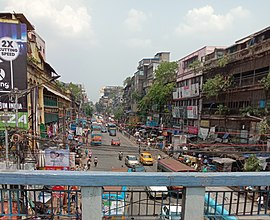Road in Kolkata, India
| MG Road | |
 Mahatma Gandhi Road in Burrabazar Mahatma Gandhi Road in Burrabazar | |
| Former name(s) | Harrison Road |
|---|---|
| Maintained by | Kolkata Municipal Corporation |
| Location | Kolkata, India |
| Postal code | 700007, 700009 |
| Nearest Kolkata Metro station | MG Road and Sealdah |
| Coordinates | 22°27′40″N 88°19′46″E / 22.461062°N 88.329451°E / 22.461062; 88.329451 |
| west end | Howrah Bridge |
| east end | Sealdah Station |
Mahatma Gandhi Road or M.G. Road, formerly known as Harrison Road, is a principal East-West thoroughfare in Kolkata (Previously known as Calcutta), the capital of the Indian state of West Bengal. M.G. Road makes the boundary of North and Central Kolkata. In 1889 this was the first street of the city to be lit by electricity.
History

Mahatma Gandhi road was initially known as Harrison Road. After the independence of India in 1947 the Harrison Road in Kolkata was renamed Mahatma Gandhi Road (M.G. Road) and the name of Chowringhee Road was changed to Jawaharlal Nehru road. In 1889 when Calcutta Electric Supply Corporation (CESC) started promoting electricity in the city, this Harrison road was the first street in the city to be lit by the authority. Calcutta Improvement Trust (CIT) decided to build the Central Avenue in 1911. By 1926, Harrison Road was stretched to Beadon Street in the north and to Bowbazar in the south.
Charu Guha, a pioneer of the city's studio photography, started her first studio in the Harrison Road in 1920. During India's independence movement, this street was previously considered as "communally sensitive" neighbourhood of the city. On 1 April 1930, The Vancouver Sun newspaper reported— "four more were killed in rioting this afternoon in Harrison Road, which is the usual storm quarter in this region."
Location and operation
The road is arterial in maintaining east–west connection in Kolkata. It is of the shortest distance between two major rail stations in Kolkata Metropolitan Area — Sealdah Station and Howrah Station. Several important places are on this road, such as Sealdah Station, Surya Sen Street crossing, Amherst Street crossing, College Street/Bidhan Sarani crossing, Chittaranjan Avenue crossing, Rabindra Sarani (Chitpur Road) crossing, Netaji Subhas Road crossing, Burrabazar and Strand Road crossing/Howrah Bridge.
M.G. Road runs from Sealdah Flyover (Vidyapati Setu) in the eastern limit to the threshold of Howrah Bridge in the west.
The road is bi-directional throughout the day. Certain crossings are, however, unidirectional, that is, in certain crossings, vehicles can turn only in a specific direction.
Culture
Education institutions

Several educational institutions are located on or near Mahatma Gandhi Road, such as Anglo Arabic Secondary School, Gyan Bharati Vidyapith, St. Paul's School, Hindu School, Lawrence Day School, Shri Jain Vidyalaya and St. Pauls' Mission School.
Restaurants
Some popular restaurants in or near Mahatma Gandhi Roadare Shreeram Dhaba, Aahar Restaurant, Madhuri Restaurant, Basanta Cabin.
Cinema halls
Several cinema halls are located on or near the road, such as Aruna, Chhabighar, Naaz, Purabi, Prabhat.
In popular culture
Rabindranath Tagore in this poem Ekdin Rate mentioned this street. The lines of the poem were— Howrah-r bridge chole mosto she bichhe, Harrison road chole tar pichhe, pichhe (the approximate English translation: The Howrah Bridge is moving as if a large centipede and the Harrison Road moves behind it).
Saradindu Bandopadhyay's famous fictional character, Byomkesh Bakshi - India's putative foremost detective, lived on Harrison Road in the second floor of a three-storied building along with his friend and associate Ajit Banerjee and domestic help, Putiram.
Gallery
-
MG Road and Strand Road Crossing
-
 Kolkata tram route no. 18 on MG Road near Howrah Bridge
Kolkata tram route no. 18 on MG Road near Howrah Bridge
-
MG Road and College Street Crossing
-
MG Road and Amherst Street Crossing
-
MG Road and Surya Sen Street Crossing
-
Vidyapati Setu, MG Road, Sealdah
West Bengal
References
- Nripati Ghoshal (May 2006). Odyssey of an Indian Bureaucrat. iUniverse. pp. 17–. ISBN 978-0-595-34753-7. Retrieved 9 June 2013.
- Sarina Singh (15 September 2010). Lonely Planet India. Lonely Planet. pp. 506–. ISBN 978-1-74220-347-8. Retrieved 9 June 2013.
- Geoffrey Moorhouse (5 April 2012). Calcutta. Faber & Faber. pp. 280–. ISBN 978-0-571-28113-8. Retrieved 9 June 2013.
- "Let there be light". The Telegraph (Calcutta). Archived from the original on 29 April 2009. Retrieved 9 June 2013.
- "Rajasthan meets Attica". The Telegraph (Calcutta). Archived from the original on 30 April 2003. Retrieved 9 June 2013.
- "An early airbrush artist". The Telegraph (Calcutta). Archived from the original on 2 April 2009. Retrieved 9 June 2013.
- "A new India mob at Raj Bhavan curfew no bar Gandhi fast Anglo-indians au revoir free Boroline". The Telegraph (Calcutta). 26 April 2009. Archived from the original on 20 August 2010. Retrieved 9 June 2013.
- "Drive Against Mahatma". The Vancouver Sun. 1 April 1930. Retrieved 9 June 2013.
- ^ "Kolkata City Guide".
{{cite web}}: Missing or empty|url=(help) (in Bengali) - ^ "Culture Mahtma Gandhi Road". Ask Laila. Archived from the original on 24 March 2013. Retrieved 9 June 2013.
- Rabindranath Tagore. "Ekdin Rate". Rabindra Rachanabali. nltr.org.
| Streets in Kolkata | |
|---|---|
| KMC |
|
| KMDA | |